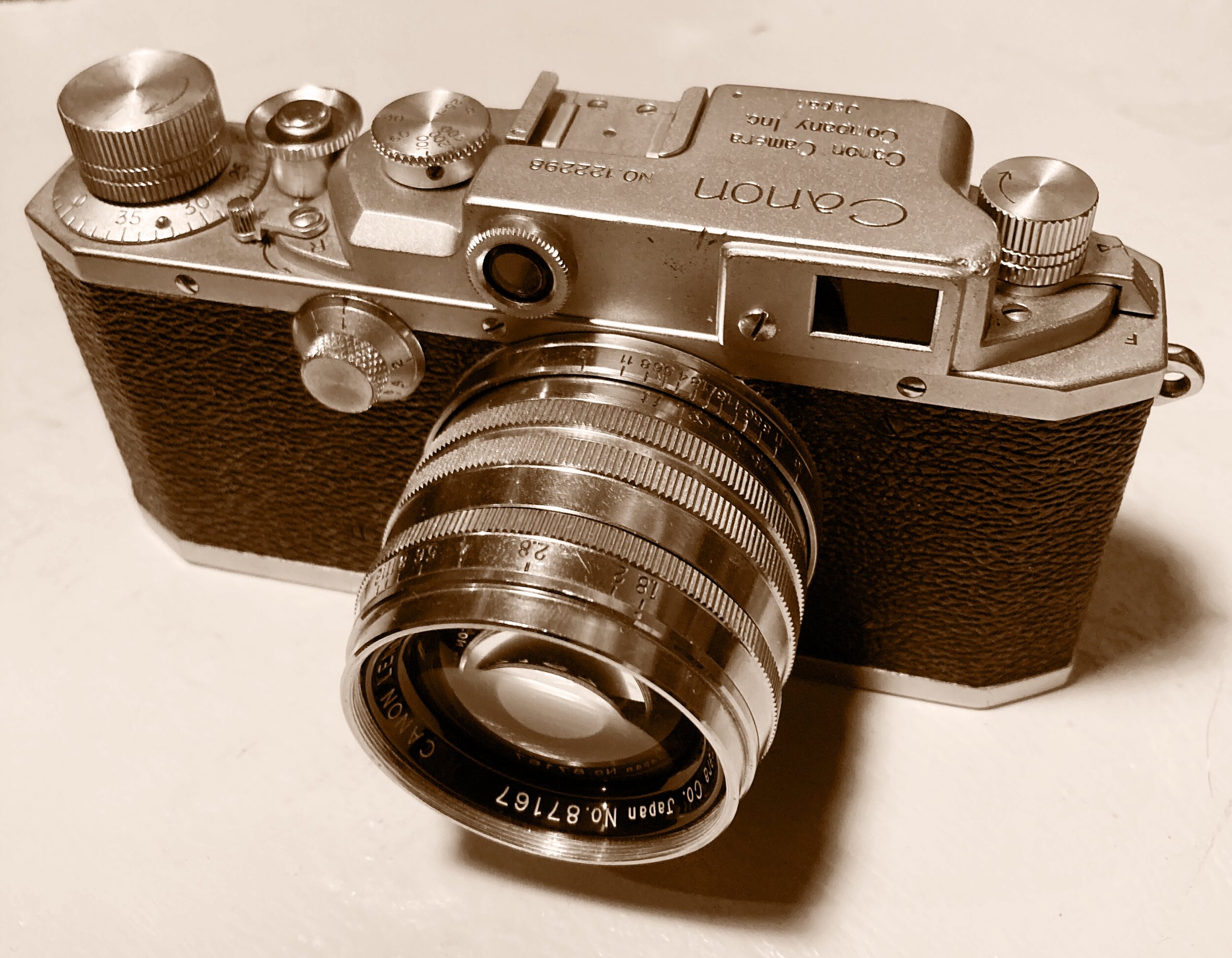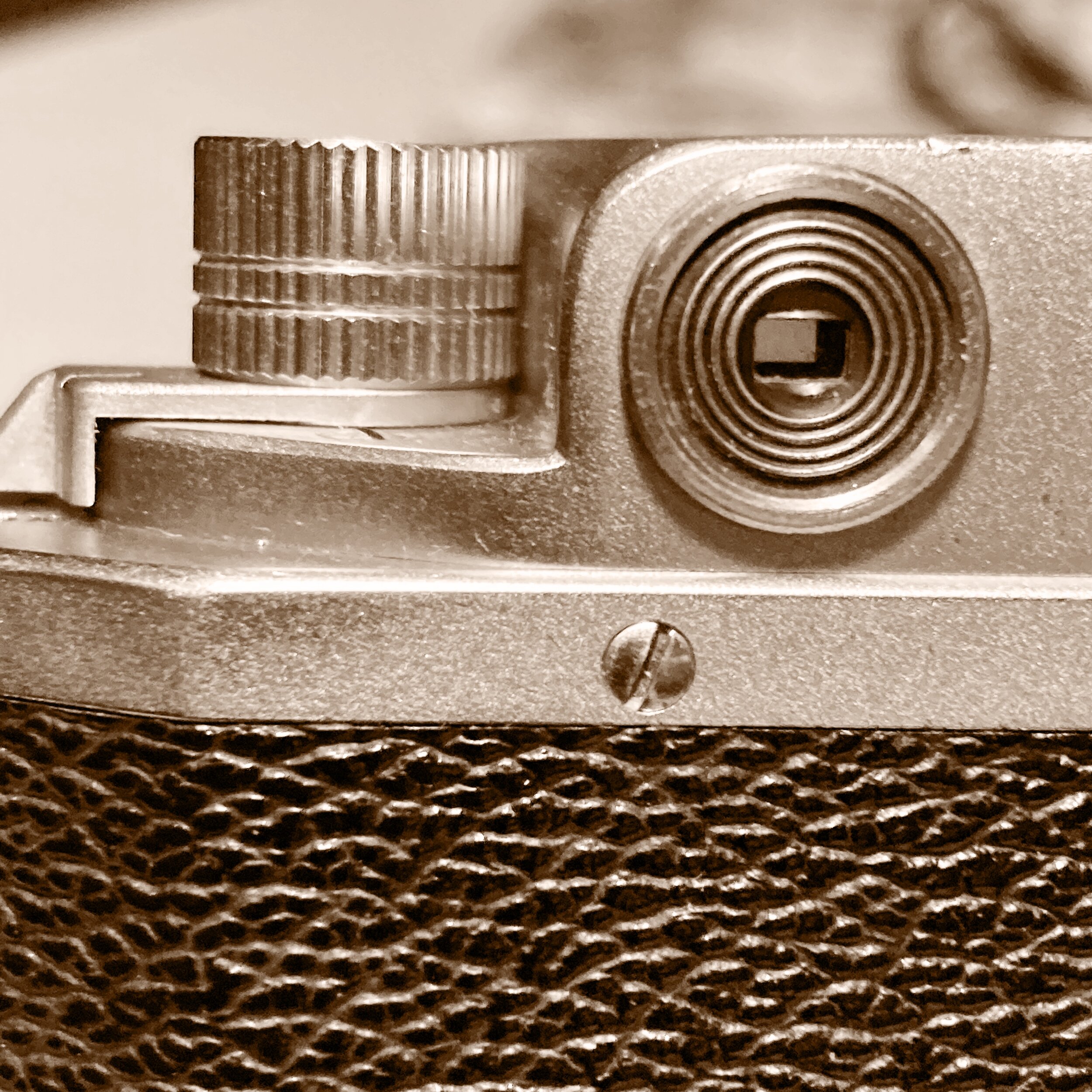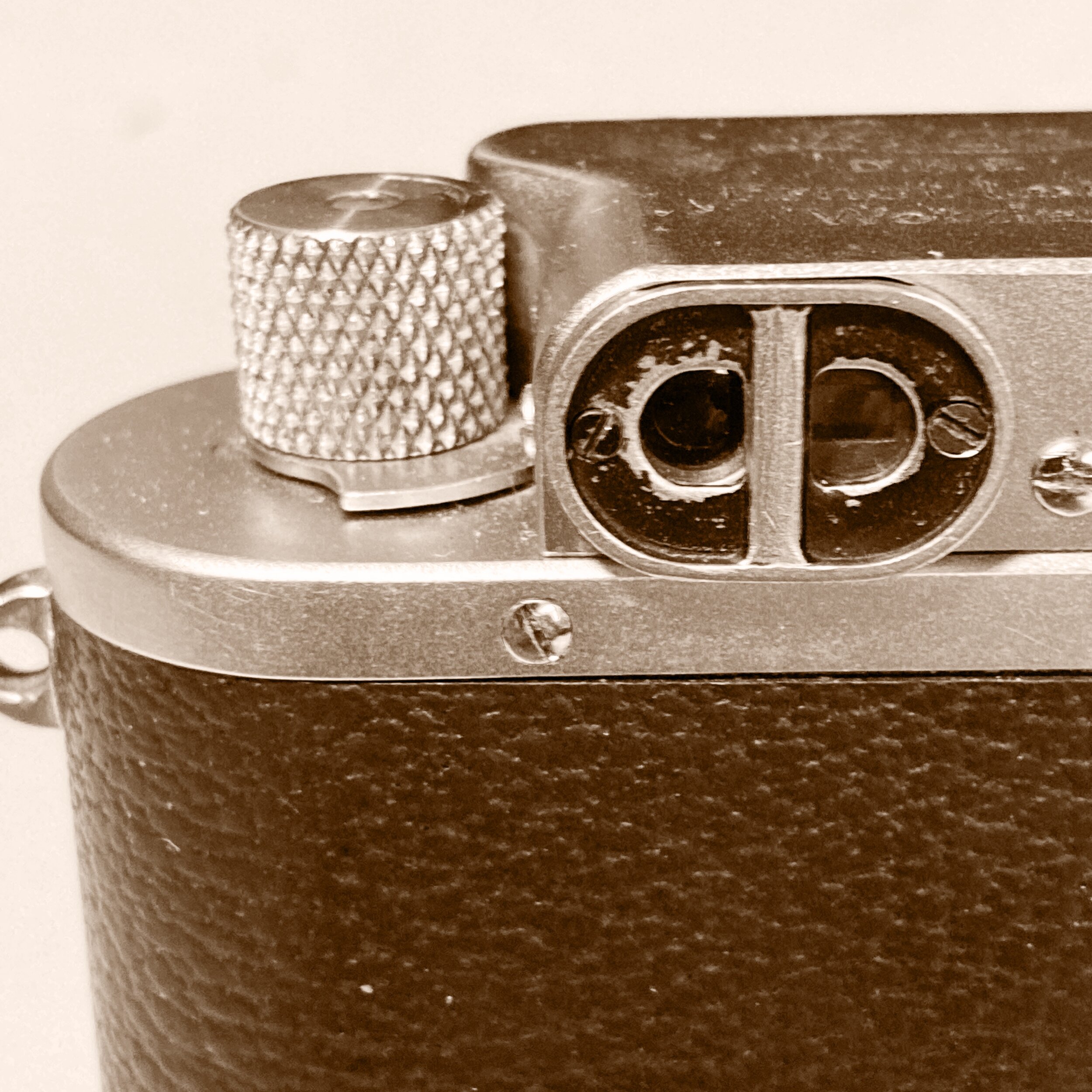When is a Barnack not a Barnack?
Question: When is a Barnack Leica not a Barnack Leica?
Answer: When it’s an early Canon … possibly.
I decided to pick up another ‘premium’ LSM (Leica screw mount) rangefinder body to act as backup to my lovely 1938 Leica iiib and at below £100 body only I picked up this lovely old 1952 (ish) Canon iid. Below half the price of the cheapest ‘Barnack’ Leica about. First impressions:
The Canon definitely feels more bulky than my Leica, a little heavier, and the squared ends of the body feel a little less ‘comfy’ in the hand. The Canon is a three or four millimetres taller and three or four millimetres longer too. The Leica iiib was the last Leica to be pressed from brass sheet. The later ones had cast main cast chassis like the Canon. Given that the Leica feels more refined and indeed luxurious … while the ‘cart horse’ Canon feels like it could take a pounding that might wreck the more thoroughbred Leitz camera.
Relative sizes:
Not much in it … but the Canon feels a lot heavier, and the angled body ends are not quite as comfortable as the Leica.
The Canon’s shutter sound is a big surprise - it’s super quiet. My Leica has a crisp but quiet plop … the Canon has a very similar sound, but possibly even quieter. The shutter release action on both cameras is silky smooth anyway.
The Leica has a smoother wind on … but not by much, and a brighter viewfinder. The ace up the Canon’s sleeve is the integrated rangefinder/viewfinder … an improvement that didn’t arrive for Leica till the M2. The Canon’s viewfinder, while feeling a bit pokey, feels more like a ‘control centre’ in the modern camera sense. The two stage viewfinder magnification switch gives a big, clear view of the rangefinder patch at 1.5x … yes I know that that switch is actually meant to act as an approximation of the 100 and 135mm lens angles of view, so you can swap longer focal length lenses without the need of an auxiliary finder for each … but at least for my eyesight the viewfinder edges are too woolly to compose accurately.
Canon viewfinder on the left … Leica on the right … yep that’s the tiniest viewfinder eyepiece I’ve ever seen!
The real eye opener is that I paid £99.00 for the Canon, half the price of my Leica body. This is practically Russian rangefinder price bracket … and the Canon is way more classy than for example my Zorki 3C which cost me over £70.00 (admittedly with a lens). I suppose the problem is that rangefinder Canon bodies are not super thick on the ground in the UK, and the superb LTM Canon lenses get snapped up by Leica owners as they are soooooo much cheaper than Leica glass. My Canon 50mm f1.8 shown in the pics came from Japan … so I had to pay customs and postage on top of the very reasonable 140 quid it cost me. If you are prep aired to shop for lenses in the ‘land of the rising sun’ you will still be paying a fair bit … for example good 28mm Canon lenses seem to fetch around £300 … but compare that to the thousand quid plus a pukka Leica lens will cost … you have a bargain … well if you want to shoot rangefinders that is!
Cheap Russian rangefinder lenses work on the Canon … at least the wide angle and standard ones … but those who know seem to think there is a basic non compatibility between the longer lenses and both Leicas and Canons … due to the Russian cameras having a slightly different lens to film plane distance. I’m going to be conducting some tests with my 135mm Jupiter 11 over the coming weeks so I’ll let you know.
The conclusion is that I absolutely love the little Canon. While obviously not as refined as my Leica its a professional feeling, solid and gutsy machine. It makes any Russian rangefinder feel a bit ‘tractor like’ … and I say that as a fan of Russian rangefinder cameras. It’s somewhat of a bargain if you accept that you’ll pay modern, medium price lens money and have to buy from japan for your optics
Above: shot with Canon iid with Jupiter 12 35mm Russian lens. Yes it has very filmic flare! But then in fairness the sun was actually in the frame … and the lens is from 1959!
Ma Mamiya … here I go again!
Mamiya C330 with 180mm lens pair and Vivitar pistol grip … a weightlifters dream!
There are quite a few reviews of the Mamiya C series twin Lens reflex line of medium format cameras online … ones that tell you how to load it, what all the controls do … so I’m not going to go into huge detail on those topics here … If after I’ve told you about my experiences with the ‘whispering bricks’ over the years you fancy picking one up … I’m sure you can do the research on the small details.
You’ll see reviews that are super glowing on YouTube for example … and ones by people who perhaps havn’t taken the time to fully understand what the Mamiya is all about so slag it off. You’ll hear people say it was meant to be a studio camera, it’s built to be a wedding camera … yada yada yada. The truth is that it was designed as an interchangeable lens system camera … a complete work horse for the ‘general practise’ photographer as they were known back in the day.
Let’s call this a long term review -and when I say long term - I got my first C33 when I was about 14. I’d sold my first pictures and fancied myself as a bit of a ‘pro’ so I figured I needed some big negative action to go with that. I shot loads on it, and adored the flash sync at all speeds, the big, clear viewfinder, and the ability (due to the bellows) to shoot close to macro with no accessories.
To cut a complex story short … as my photo work changed I used 35mm SLRs more and the C33 less. I was shooting fast action subjects in situations where weight and portability of kit made the poor old Mamiya a bit of a millstone around my neck. So I sold my old ‘33’ and sunk the money into more 35mm gear.
Fast forward to my big move to London and my need to earn my rent reliably. Wedding photography was a good meat and potatoes living … but my 35mm kit wasn’t best suited.
The Mamiya TLR, with it’s square format (beloved of many generations of wedding photographers) was the ideal tool that most importantly wouldn’t bust my budget. So I acquired another C33 with 65, 80 and 135mm lenses. The Mamiya was in it’s ideal environment … and I did ,, many dozens of weddings with that kit.
At this point I should highlight that the C33 was always on a Tripod for wedding work … and that’s by far the easiest way to use one for any purpose. The tallness of the camera makes getting horizons that aren’t on the ‘wonk’ a little problematic if you don’t have a stable reference platform. The weight is crippling on a neck-strap for any length of time (especially with a long lens) and although a ‘hand grip’ helps … you need to have had a damn big bowl of Weetabix before hefting one out on a long photo-walk or hike. Experienced Mamiya C series users can be seen resting the camera down one forearm while carrying to take the weight off the neck strap … or holding the rig by a grip and resting the camera body on their shoulder. You learn to get weight-smart.
The compensations are a whisper quiet shutter (it makes my Leica sound like the report of a 50 calibre rifle), a super-fast wind on crank … and lenses that can really only be bettered by Hasselblad ones.
Yes C series TLRs must be addictive … I’ve bought into the system three times in my photographic career, and my current C330 feels like coming home again. The 330 is a smidge lighter than the C33 but only mouse’s handbag lighter … it’s still a beast.
Yep Parallex is a pain: the fact that the viewing lens and taking lens don’t quite have the same view. There’s an indicator in the viewfinder mind, and after a while dealing with it becomes second nature. Sure you can splash out on one of those ‘Paramender’ gadgets that raises and lowers the camera by the two inches between the taking and viewing lenses … or you can use my old trick and use a Sharpie to mark one inch increments on your tripod centre column … or you can use a 35mm film canister to measure … those are two inches long!
How about macro down to 1:1 without any extra accessories? Easy when you have bellows built in!
Sure it’s not a fabulous camera for gradient filter users … but it is amazing for infrared as you can focus without having to take an almost opaque filter on and off!
Let’s put this into perspective my current C330 with three lenses … an, 55mm and 80mm 180mm, cost me sub 550 quid … what other medium format 6x6 camera and lenses could you get for that kind of money? You are in Russian Hasselblad or Pentacon 6 copy territory … with questionable engineering and reliability. Contrast this with C series Mamiyas that were built to be bombproof and stand up to professional use … there is no real comparison.
Glorious 55mm Mamiya-Sekor wide angle
So the C33/C330 series is way off perfect for all jobs … and to me the C22 and C220s would seem a bit slow to operate. With their lack of auto shutter cocking … but then I’ve never tried one in anger. Sure you can get a Mamiya 645 with a standard lens for close to C330 money … and it’s a SLR … but like most 645 SLRs it’s not at its most comfortable when shooting in portrait format … and you get a bigger 6x6 negative with the C series that you can crop to 645 in portrait or landscape if that floats your boat.
The RB and RZ 67s from Mamiya are lovely, and of course SLRs … plus have the advantage of a bigger negative still … but are heavier even than a C330 (and indeed heavier than a small planet) and hand holding is pretty much out entirely … and you won’t get extra lenses at the rock bottom prices you can find C series ones at.
How many cameras actually remind you what you do (or did) for a living? Priceless for semi senile old duffers like me!
If the financial fairy has really pooped in your cornflakes and you still want to shoot film in medium format a Yashica 124G TLR: great quality even if you miss out on the interchangeable lenses.
If you are even more impoverished Sure could buy one of those old folding cameras with fixed lenses like the Zeiss Nettar (I have a couple of them kicking about, they are as cheap as chips) but the slow shutter speeds tend to be very hit and miss, and light leaks are common.
Former Soviet Union built medium format cameras like the Kiev 60 are as ugly as a very ugly Pitbull, sucking a vinegar covered wasp, and have suspect quality control, and more than a vague niff of tractor oil. The East German Pentacon 6 which is a very close relative suffers from more than its fair share of shutter and frame spacing issues so can be more trouble than its worth, especially if it hasn’t been well looked after.
If you are one of these people who have bought into the Holga/Diana ‘Christmas cracker’ plastic fantastic 120 trip: personally I don’t see the point. The Diana ‘toy camera’ is currently selling for around £70.00 that’s about £65 too much in my book. Oh and Holgas (a snip at £35.00) are just horrible, and somewhat pretentious too. If they were cheap I could see the point, but their main function seems to be as a talking point for when hipsters gather together to imbibe craft beers and compare man-hats. The Holga has ‘Optical Lens’ emblazoned around the business end … I mean what other sort of bloody lens would one have on a camera, a cheese one?
So … if one wants to take 6x6 photographs on a budget but without compromising on reliability or build quality …
Ma Mamiya … how could I resist ya?
A thing of beauty is a joy for … 83 years!
My 1938 Leica iiib with a 1950s Canon lens fitted
Hi and welcome to my first ever blog post on this site. I’ve had a presence for a while on YouTube, but I wanted to have somewhere where I could ramble on about photography and cameras without having to look my best, or even put clothes on at all - optional at home during lockdown- but not optional on YouTube! So dear reader you will never know if I have me trousers on or not for this!
I’m not one of those dyed-in-the-wool Leica fan boys who would use nothing else, or has been obsessed since popping from the womb, yelling: ‘give me my Leica M3 bi-atch’ (much to the surprise of the midwife). No, quite the opposite actually, for much of my photographic life - including the quite large bit where I got money for taking pictures - I saw Leicas as somewhat outmoded status symbols, brandished by ‘jolly nice chaps’ who likely wore tweed underpants and drove Morgan three wheelers. My weapons of photographic choice were motor driven Nikons and Mamiya medium format … German cameras seemed to belong to my father’s generation and so weren’t relevant or ‘hip’.
So what happened?
Well I started taking photographs on film again - after seeing out the latter years of my photo career on digital cameras - for a start. I also started to see virtue in simplicity - after wrestling with the god awful menu system in the Panasonic Lumix I use for shooting the video for my YouTube vlogs! I started to think about the environment … and there’s something wonderfully economical and carbon neutral about using a camera built while my mum was in nappies.
I bought a digital Nikon when digital was new … beautifully made, and sporting 6.1 megapixels of gorgeousness … it dented my bank balance by around £2000. One sold on eBay for sub fifty quid a couple of weeks ago. In 18 years my camera had become pretty much worthless; just like an 18 year old computer or a ‘Now That’s What I Call Music 53’ CD from the same year. All the industrial might that built the sensor and the pay for the stylists who designed the body … now just one small step from a back shelf at Cash Converters and one faulty component from landfill.
By this sad logic the Sony Alpha 1 mirrorless camera that has recently been released on the painful side of six grand (over £6000 pounds for those of you of the American persuasion) will someday in the not-too-distant future be available on eBay for close on bugger all! All flesh is grass you may think … such is the way of progress … but still my pre war Leica trucks on defiantly. The amazing thing is It’s worth as much now, relatively speaking, as it was when Neville Chamberlain went to Germany, gave Hitler carte blanch to large it up on Czechoslovakia and came home declaring "Peace in our time" like a total twat*.
The thing is, eighty three years after it was made it’s still every inch as good a camera as it was in 1938. Pop a 2021 film into it and it will deliver fully ‘professional results that nobody will poo poo through not having enough magic pixies … sorry megapixels. The strange bit is that a camera made 18 years ago, contributed images to newspapers, took pictures that graced the front of West End theatres like my digital Nikon did … is now seen as laughably primitive … as we peek at our 50+ megapixel images from the latest generation of ‘soon to be landfill’.
Is it just me or does all this ‘buying new stuff’ shit have to stop at some point? People bang on about analogue photography chemicals damaging the environment, but I’m actually more worried about all those lithium batteries and rare metals that come from making our latest man-toys. With a bit of extra research to improve photo chemicals analogue photography could easily be the green alternative to constantly watching our sexy new investments turn into bargain basement eBay fodder.
*Cameras got more bells and whistles but politicians are still pretty much still as stupid











